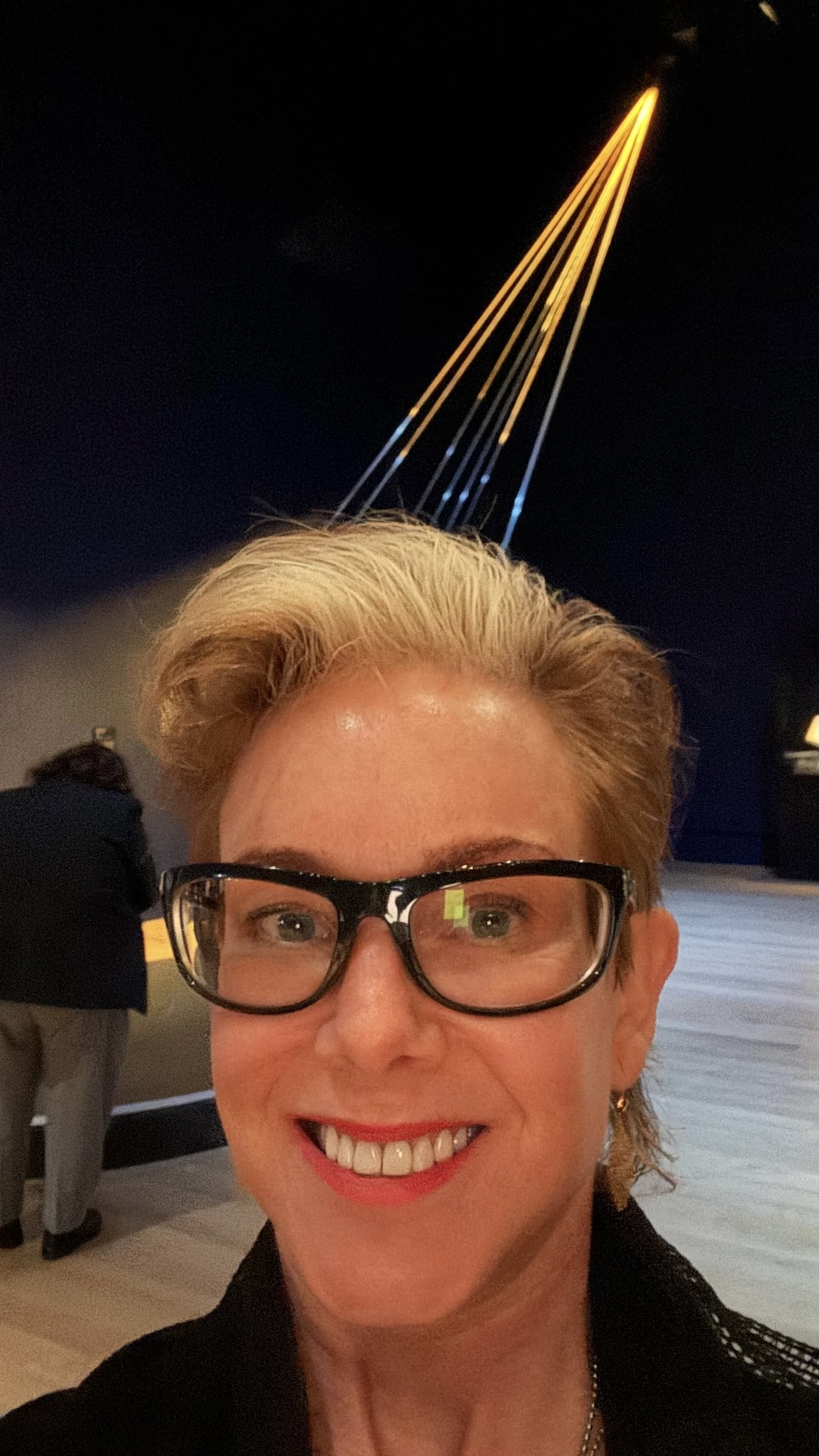
E.V. Day in front of her installation Golden Rays/In Vitro at Getty Museum
E.V. Day’s work considers feminism and sexuality, often within the context of popular culture and in the form of suspension-based installations, ranging from deconstructed couture to skeletal big cats. Based in New York, she has been artist-in-residence at Versailles Foundation Munn Artists program at Claude Monet’s Garden in Giverny France, Artpace San Antonio, and the American Academy in Rome. Her work has been shown at The Whitney Museum of American Art, Herbert F Johnson Museum of Art at Cornell University, Lever House, and Lincoln Center, among other institutions. Her most recent solo exhibition “Velocity Drawing and My Crazy Sunshine” featuring mixed media two-dimensional work was on view at Baldwin Gallery in Aspen, CO from July 26 – September 2, 2024, and her installation Golden Rays/In Vitro is currently on view at Getty Museum as part of “Lumen: The Art and Science of Light” through December 8, 2024.
Interview by Devon Dikeou
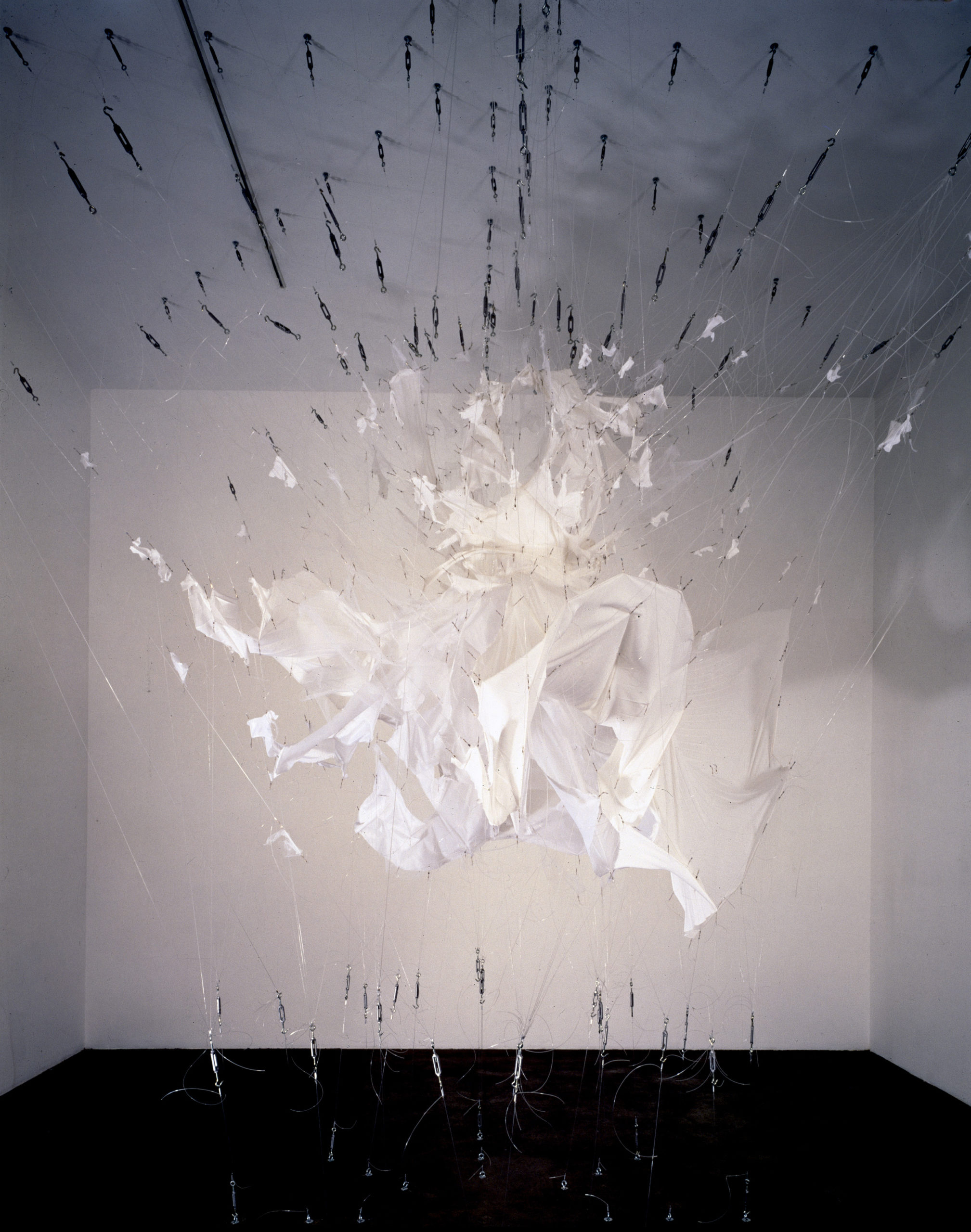
E.V. Day, Bombshell, 2000, white crepe dress, tulle, hardware. 16’ h x 16’ w x 16’ d
Your career bio cites your work in some interesting collections, among them the Smithsonian’s National Air and Space Museum . . . And in your work there is a question of velocity vs stillness that is very much what the National Air and Space Museum is about, a museum that brings things that garner such otherworldly force to a standstill . . . That impulse very much embodies your work, I’m thinking saber-tooth tigers suspended in animation while in the midst of a fight, familiar opera costumes dancing in air without their divas. Rockets in wait, sans flight . . . Iconic dress in exploding deconstruction without the icon . . . Talk about what attracts you to this juxtaposition . . . Of velocity and stillness . . .
I feel the relationship I am after or the juxtaposition I am attracted to is more “velocity” and “capture.” Capture by freezing time. I’m looking for that juicy moment before the subject dissolves into something unrecognizable. And I am not just freezing the moment but animating it. Like Harold Edgerton’s famous flash photograph of a bullet’s penetration through an apple. I’m especially drawn to the fragments that result from the forward thrust of the projectile and the bits of debris from the part the bullet passed through. The magic of this experiment is that the core of the apple is still intact at that moment. I like the image of rupture coming as well as going. This is the kind of energy I want in my sculpture.
Rupture and capture are an essential relationship in many of my sculptures. Bombshell, from the “Exploding Couture” series, is a perfect example. But it’s different from the action of Edgerton’s photo, because I’m not portraying forces of penetration. I’m animating the garment by pulling it from all directions as if the explosive force of raw energy comes from within the dress. The power is generated inside. The “suspended sculpture,” as I call it, is trussed up in a gesture that suggests the familiarity of the iconic image of Marilyn Monroe’s billowing dress from the iconic scene in The Seven Year Itch (1955). Frayed fabric and debris of the partially deconstructed dress are suspended with tension of the fishing lines, and they appear as projectiles directed away from the center. I use tension as a material. Without the tension on the lines, there would be no sculpture. It’s a tensile sculpture.
I also think of what I do as drawing lines in space. Visually, the translucent lines glint when lit, like contrails of the tattered fabric. The monofilament suggests movement by the way the light interacts with the translucency of the material and at the same time it’s literally capturing the material. It’s all a paradox: stillness and motion, tension and release, all captured at the same moment. The tension on the lines themselves is somewhat ethereal but it is also the scaffold holding everything together.
Another aspect of capture is suggested or emphasized by the oversized tensioning hardware I use to anchor the lines into the floor and ceiling. I want to emphasize these terminal points to suggest the strength and force, the power and velocity it takes to dismantle such a stubborn societal cliche fixed in place by “the male gaze.” And by attaching the lines to the floor, ceiling, and walls, it suggests this problem of sexism, living through the male’s perspective, is part of the very architecture we inhabit—the social fabric. If these images of my Bombshell sculpture were as familiar or became as iconic as the Marilyn Monroe picture, it would be a great victory. I want the explosion to be ecstatic, orgasmic. The work is a rebellion and celebration of female empowerment. A visual explosion, a moment of transformation frozen in time.
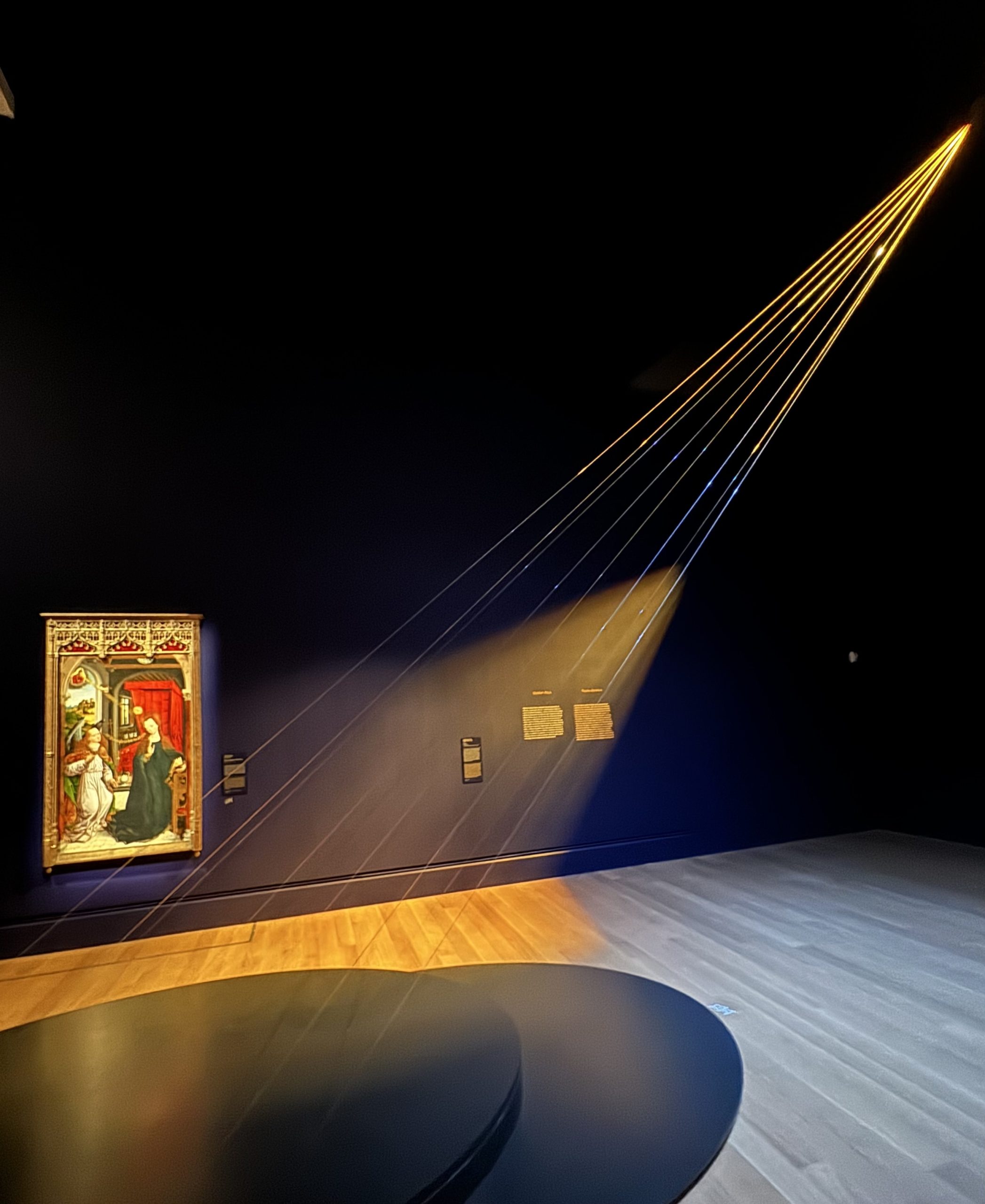
E.V. Day, Golden Rays/In-Vitro, 2024, aircraft cable, gold leaf, monofilament and hardware, outdoor/indoor installation 40 ft and variable, (installed at the Getty Museum, 2024)
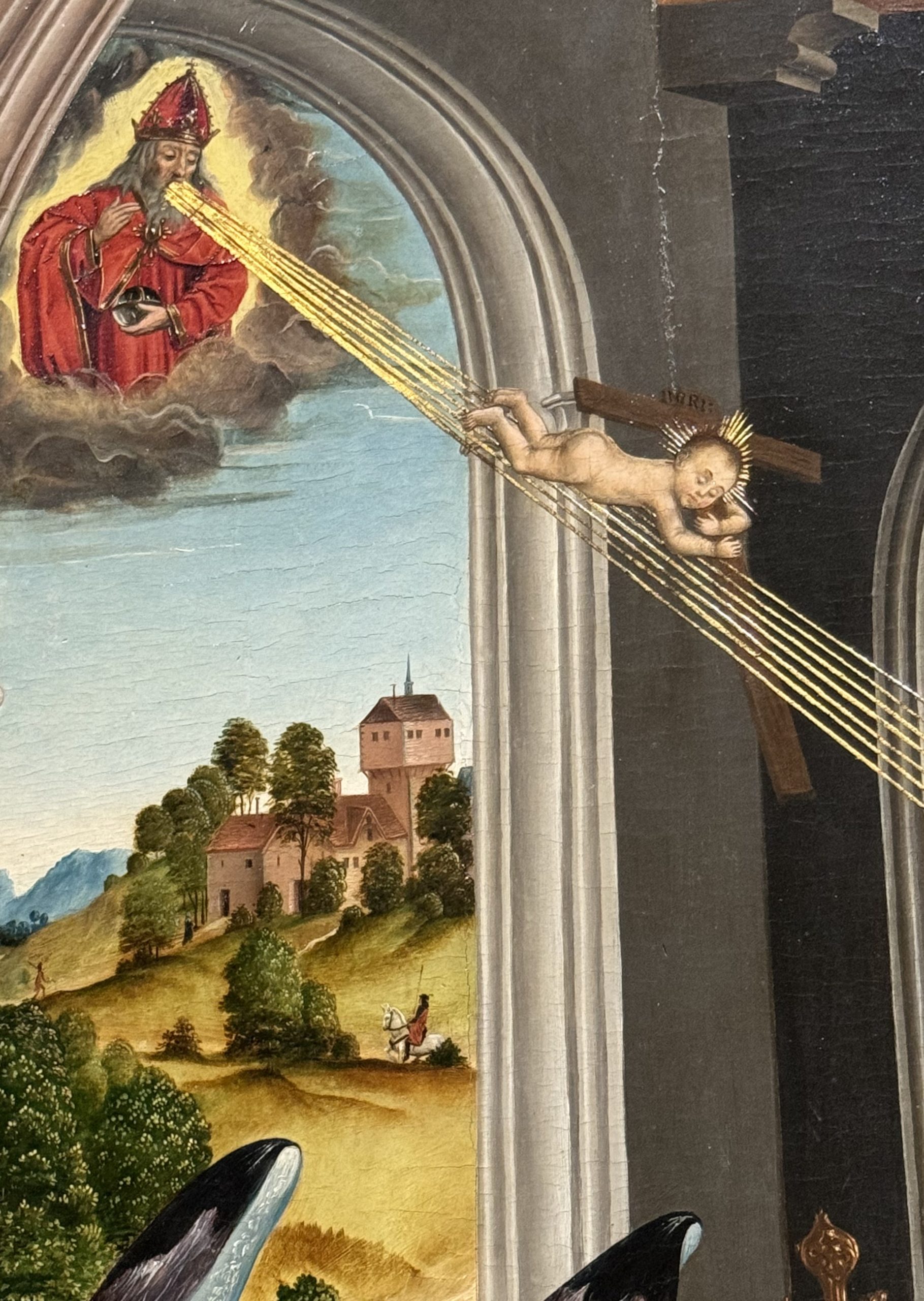
The Annunciation (Detail), Master of the Retable of the Reyes Cathólicos, Spain, 15th century
Which brings us to the illusion of movement in your work . . . A spiritedness both in subject and realization that teases movement but only in an illusory manner . . . I’m thinking of your Rome Prize installation Golden Rays/In Vitro a glass bending illusion of ethereal light from god or sun made sculptural and literal . . . Please elucidate . . .
My first stop in Rome was to see Bernini’s Ecstasy of St. Teresa. This marble masterpiece captures the saint writhing in ecstasy on a cloud that seems to float. But it wasn’t the depiction of a saint experiencing an orgasm that fascinated me, it was the golden rays in the background that activate her and set the entire ecstasy scene in motion—complete with an angel about to launch a golden arrow at her heart.
The rays are made of streamlined, gilded strips of wood, which contrast sharply with the otherwise heavy materiality of the baroque stone carving. Their sleek, modern look reminded me of modernist art of the 1950s and ’60s often seen in bank foyers. They also resembled renderings from science fiction films—images of transport beams like “Beam me up, Scotty” or the exaggerated rays from a cartoon ray gun.
From there, I began collecting hundreds of images of golden rays from paintings, most of them depictions of the Annunciation from the medieval and Renaissance periods. I also gathered images of light beams from science fiction illustrations and films. I connected the two and started calling them “Shazams.” The rays in Annunciation scenes became rich material for me to explore themes of overt sexism in the Catholic Church, especially around Mary’s “non-consensual” impregnation and the concept of the Immaculate Conception. If pregnancy occurs without the intersection of male and female sex organs, then where does it happen? In a petri dish? It felt like an early suggestion of in vitro fertilization, and the golden rays themselves seemed to resonate with contemporary communications, satellites, laser beams, fiber optics, and Wi-Fi.
I wasn’t sure what to do with this obsession at first, but I eventually decided to create some golden rays of my own. I suspended gilded aircraft cables through my studio skylight, 32 feet above the floor, extending them out a pane of glass to a gravel terrace 45 feet away. The installation worked best at night when it could be illuminated, but during the day it almost disappeared, becoming lines that captured light.
Rays of light are ethereal, much like the concept of God. Light is intangible, and in creating my rays I was trying to materialize that intangible quality for myself. This is where my sculpture, Golden Rays/In Vitro, originated. It feels like a miracle, perhaps even from God, that my rays—which I recently installed in The Getty’s show “LUMEN: The Art and Science of Light”—landed in this exhibition about light in art from the medieval and Renaissance periods, surrounded by artworks that inspired my sculpture. The Getty commissioned me to re-make Golden Rays/In Vitro as an indoor piece, and it’s suspended in the gallery right next to an Annunciation painting that I had used as a source image. The context is perfect!
Light and rays are not physically tangible, but they carry a mystical power, an invisible force, announcing divine presence. You can’t capture a ray of light with your hand but you can feel its warmth and energy. I often find myself trying to make the ethereal tangible.
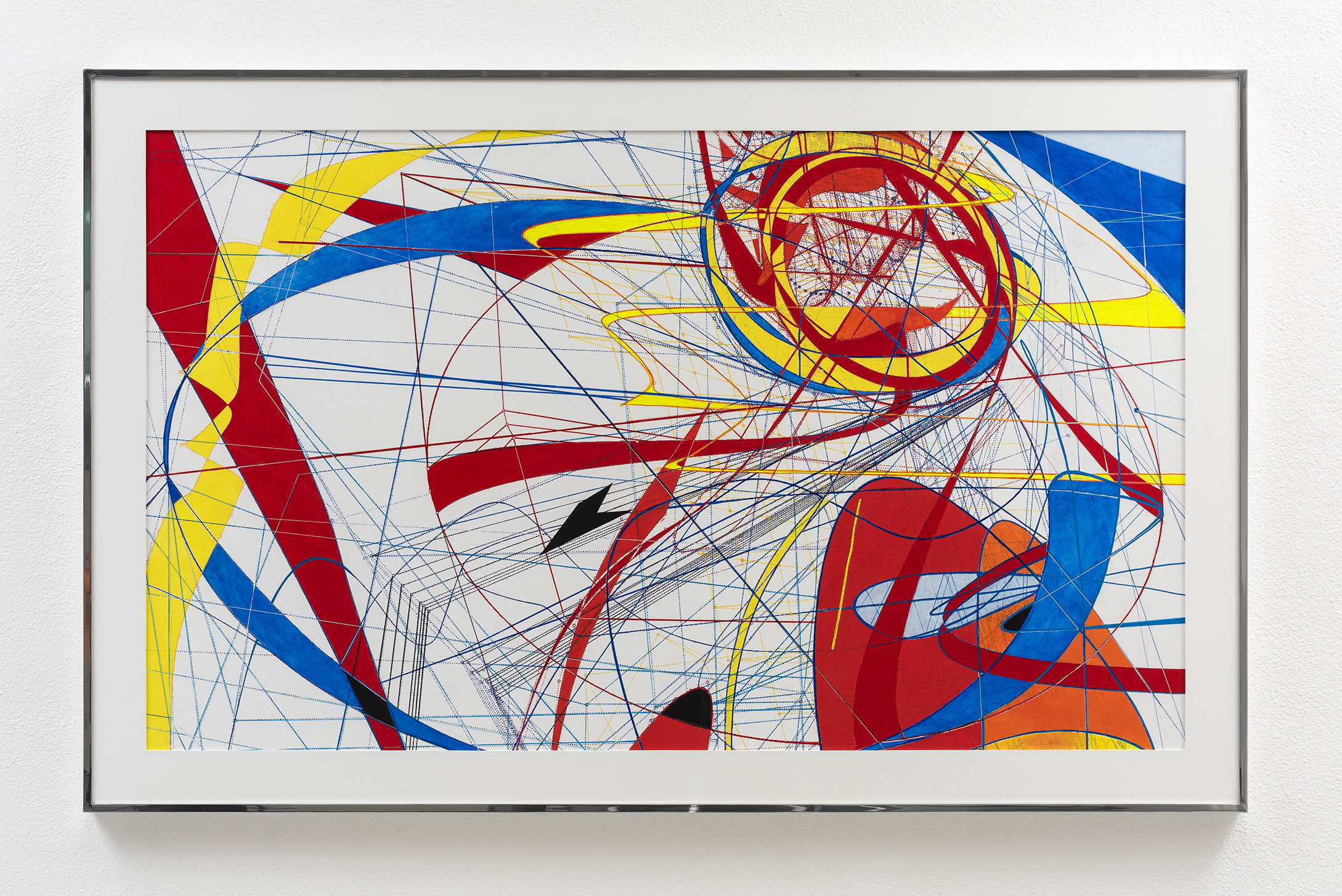
E.V. Day, My Crazy Sunshine I, 2024, paint and pencil on paper, mounted on board, 36” h x 60” w
But moving onto the series of two-dimensional works at Baldwin Gallery in Aspen . . . The twenty pieces titled “Velocity Drawings and My Crazy Sunshine” still capture the essence energy and motion while resting firmly within specific two-dimensional confines, even frames . . .
The drawings at Baldwin Gallery, which was my first show of two-dimensions, are soaked in the aesthetic of Italian Futurism—I emphasize the aesthetics, not the Fascist politics of that era. It was a time of industrial acceleration, much like the technological speed we experience today with computers and AI. I’m drawn to the aerodynamic style and the promise of velocity it represents. In college, when I discovered Italian Futurists like Balla and Boccioni, I had an “a-ha” moment—I suddenly felt connected to their vision of a world shaped by cars, trains, and airplanes, all designed for speed. This phenomenon feels similar to the acceleration of today’s tech evolution, like Apple’s sleek “retro space-age” designs in white plastic. What I love about Futurist paintings is their attempt to render transcendence—pushing beyond the still-life to capture motion.
Other influences of mine include Moholy-Nagy’s plexiglass drawings, photograms, and Brancusi’s sculptures, which are full of velocity. Growing up, I attended vintage car races with my dad, who used to race a 1949 roadster. I loved the feeling of speed, the centrifugal force of turns, the sound and smell of it all. Coincidentally or not, these drawings have an automotive origin story. I was commissioned by Jimmie Johnson, the NASCAR Cup Series Champion, to make an artwork from the fire-suit he wore in 2006 when he won his first Daytona 500. He and his wife, Chandra, collect contemporary art, and had seen my work. For my proposal, I made a 3-D wireframe model of the suit in a state of suspended deconstruction. Once complete, I experimented with distortions of the wireframe model and all kinds of dramatic compositions evolved. It was so much fun, I wanted to live in the drawings! The lines felt like they cut the space with velocity just the way I like it. I started putting them on paper and canvas, using only the colors in the suit, with pen, pencil, and paint. So, the “Velocity Drawings” were born, and the next composition series became “My Crazy Sunshine.” I have never made something so bright and sunny, it seemed crazy. So that’s the title.
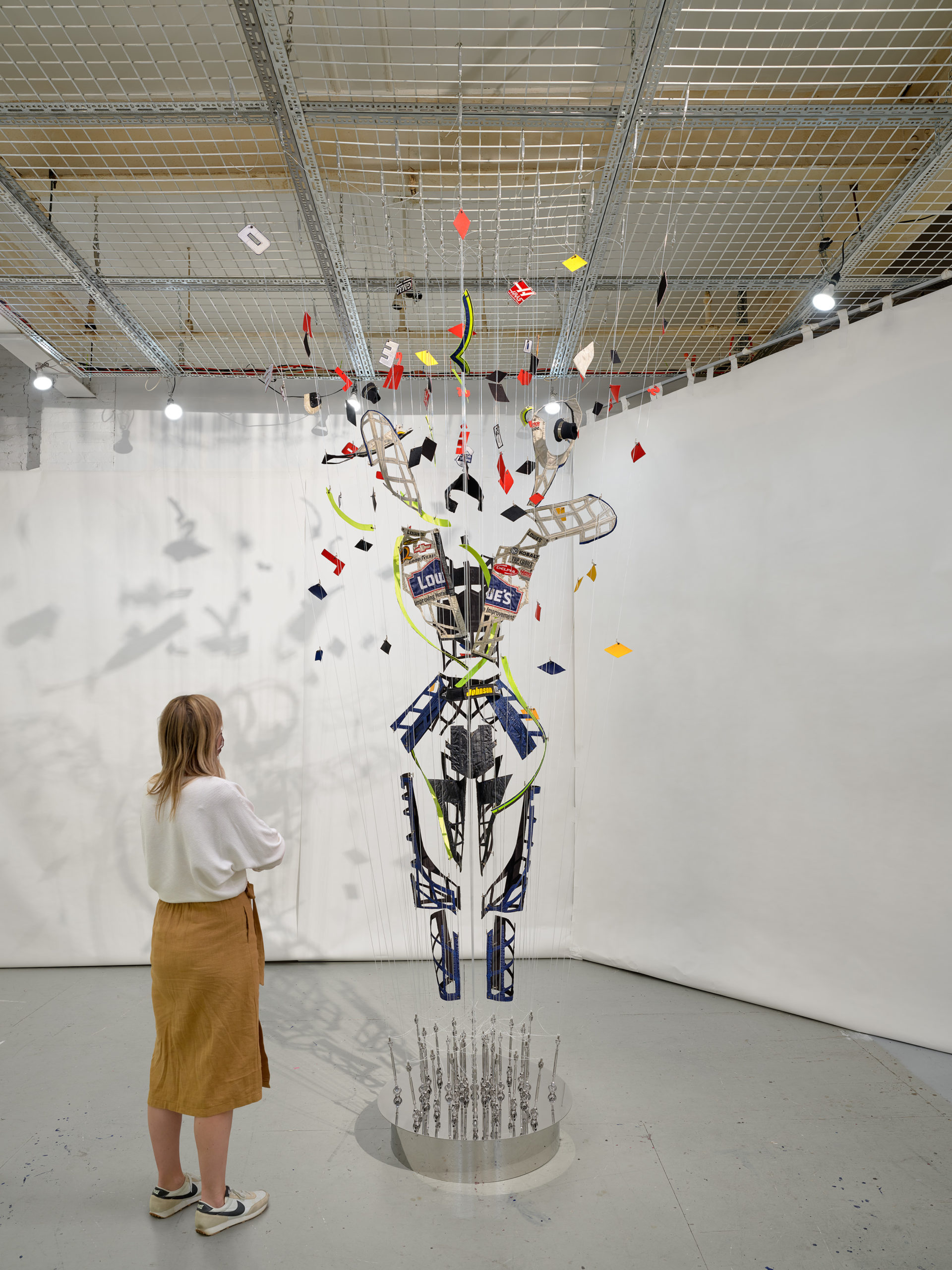
E.V. Day, Daytona Vortex, 2020, Commissioned sculpture for Jimmie Johnson, NASCAR fire suit worn by Jimmie Johnson at his first Daytona 500 win, monofilament, hardware, and mirrored stainless steel base, 149” h x 96” w x 96” d
Some pieces even cite Zaha in the title . . . Is that a reference to Zaha Hadid, who in my mind certainly embraces ideas of futurism in her architecture . . . Can you address Zaha, and titles in general.
For me, Zaha Hadid captures the narrative of speed better than anyone. I first discovered her work when in college while browsing architecture magazines in the library—a habit I miss for the serendipity of finding new things. Her drawings felt so familiar, almost as if I already knew them. It took me a while to realize that Zaha Hadid was a person, not a movement or collective, and even more surprisingly, a woman! Back in the ’80s, technology hadn’t quite caught up with her vision, but she was already speaking to me through her work.
These two drawings are in the “Velocity Drawing” category. They’re identical but face away from each other—one in a bluish palette, the other in yellow. I felt like I was plagiarizing her work, though I couldn’t find the exact drawing I was thinking of. It’s an ode to her. When asked who I’d want to share a two-person show with, I said, “A Zaha Hadid building.”
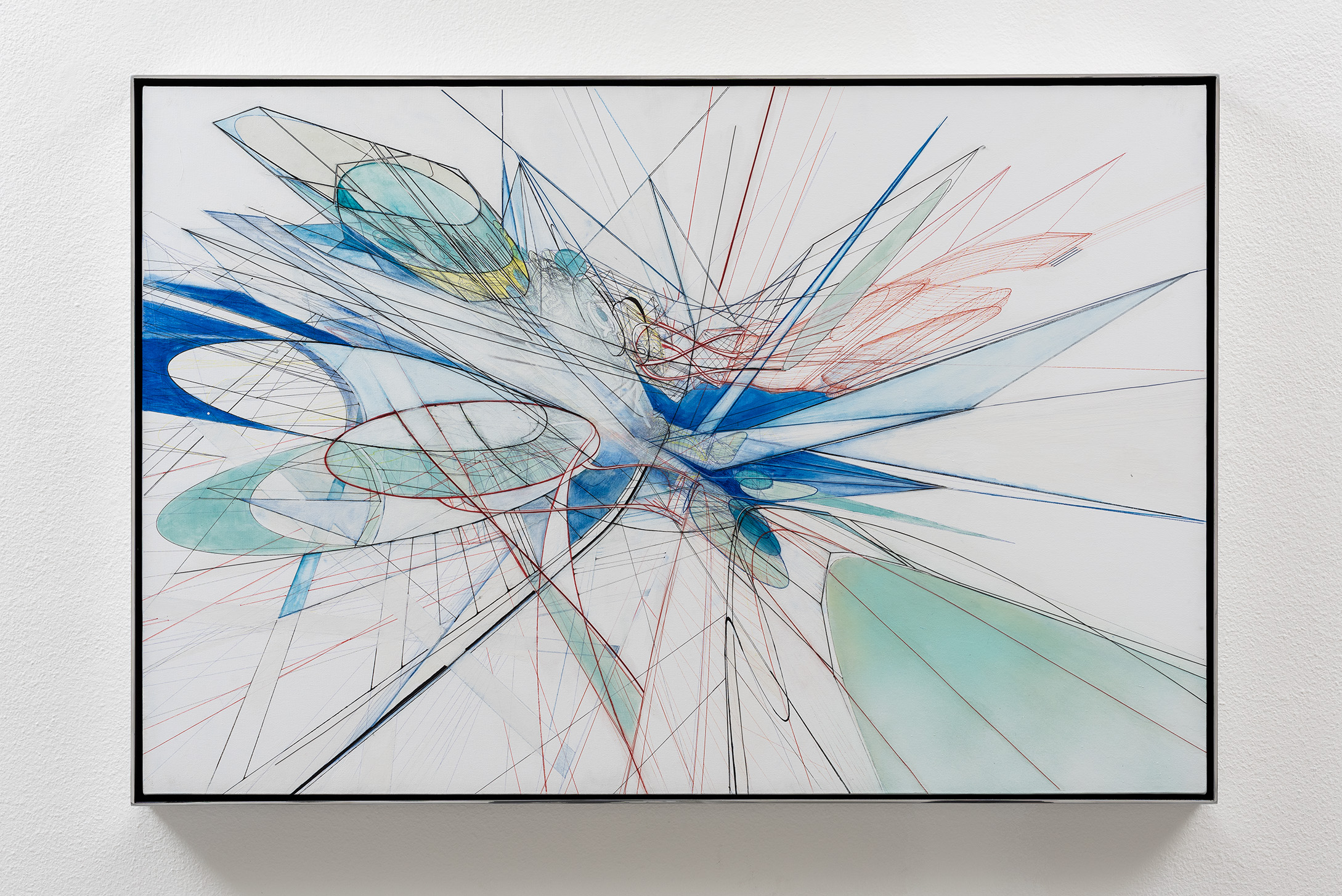
E.V. Day, Flyby Zaha (Blue), 2024, Paint, ink, tape, acrylic medium, pencil on canvas, 32” h x 48” w
A couple of spacemen and ghosts of the commercial Lowe’s logo crop up in these drawings that bring a more contemporary pop touch (Rosler/Warhol) while also making reference to the grandfather of movement Cubism and collage . . . Speak about elements of collage and or pop in your work . . .
I’m a fan of pop art; my work often originates from themes addressing popular culture, but it is definitely not pop art. In some of the drawings, I collaged images of astronauts that I screen grabbed from 2001: A Space Odyssey (1968). The figures’ spacesuits show a cut cord as HAL has ejected them from the mothership. They are floating toward an energy field or a black hole. I imagine the drawings as immersive and infinite, so I included those untethered little spacemen for scale.
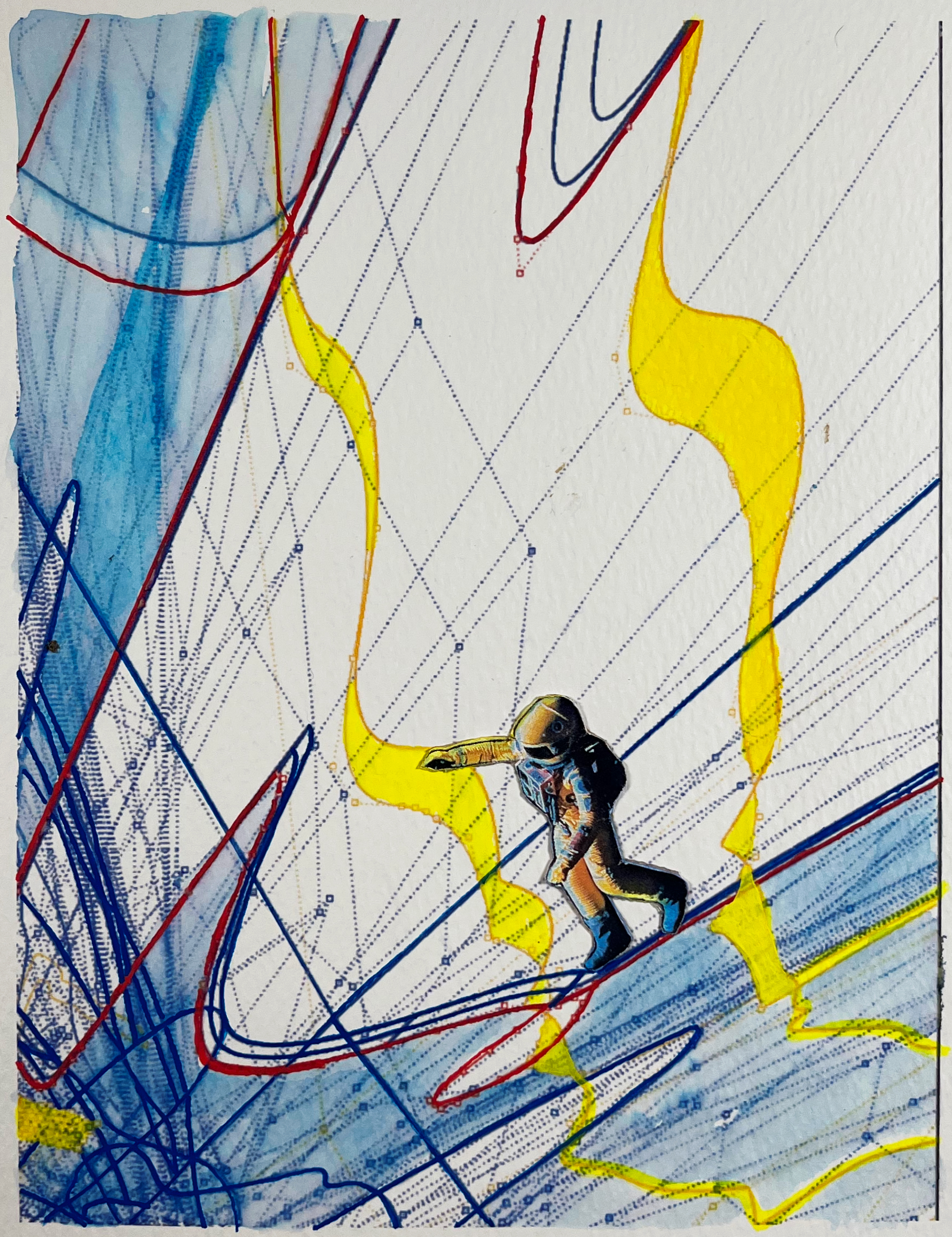
E.V. Day, Spacewalk, 2024, paint and pencil on watercolor paper, 11” h x 8.5” w
Lastly, Edison or Tesla . . .
Tesla, of course, but I’m not eager to own the automobile version. They are prematurely “automatic,” driverless, etc. Tesla was a creative genius; Edison was an all-out marketer who exploited him for his ideas. I read that had Edison not marketed electronics, we might have free electricity. Tesla is my man; I even made an artwork called Tesla’s Mistress. It’s a bit melancholy, but I wanted to honor him in some way regarding the visualization of electricity. This idea came about as I was interested in trying to visualize the flow of electricity. In his biography, it is said that he never had any romantic relationships, but at the end of the book, he has the companionship of a pigeon/dove that visits him regularly at his window in the New Yorker Hotel building, where he died alone and impoverished. Very operatic. It could be a good story for an opera, with the rivalry between Edison and Tesla, where the main character who dies in the end is male, as opposed to the usual woman . . .
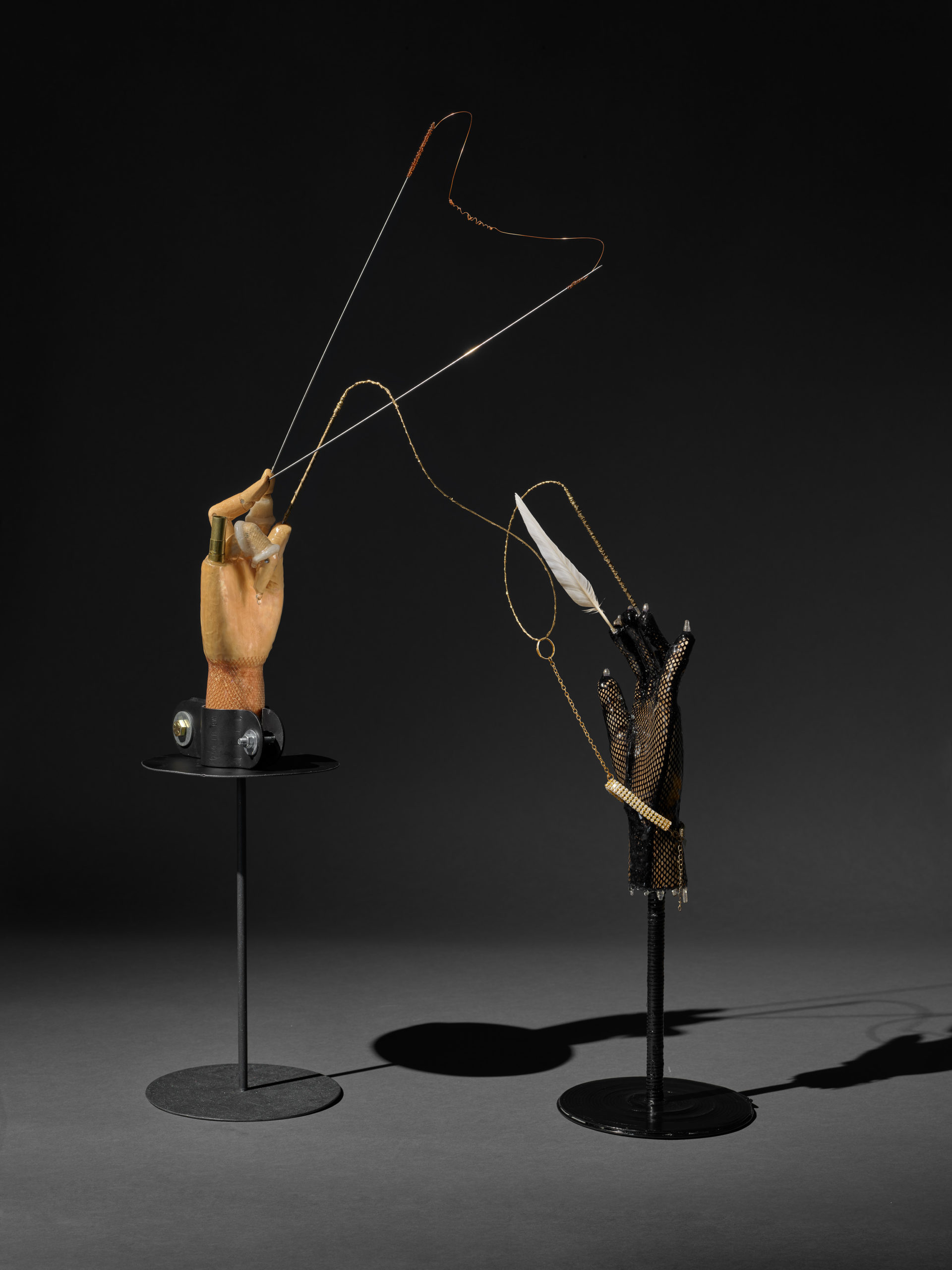
E.V. Day, Tesla’s Mistress, 2020, Wooden mechanical hands, fishnet glove, metal, gold leaf, rhinestones, resin, and feather, 36” h x 22” w x 9” d
To return to your question about NASA: I was commissioned by NASA to create an artwork for the Smithsonian National Air and Space Museum. I was invited to visit the Jet Propulsion Lab north of Pasadena, where I met rocket scientists, engineers, geologists, and astronauts. At first, I felt like a fish out of water, but quickly realized about these experts that we had more in common as we are all explorers, dreamers and problem solvers. Most artists I think are curious people, trying to satisfy something that’s never existed before, by exploring, experimenting, and optimism about potential discovery. Problem solving. If there is any overriding theme to my process as an artist, it is problem solving. Experimenting with combinations of materials that are new to me, logistics, learning about the infrastructure of various museums and buildings to figure out how to securely hang my artwork. Like with Golden Rays/In Vitro piece I mentioned that I recently installed at The Getty, which is a Richard Meier building, you’re not allowed to paint or touch the exposed, brawny I-beams in the ceiling, as mandated by Meier. And the floor similarly cannot be marred in anyway. So, it’s been a real creative workaround with the installation team and exhibition designer, and we figured out how to make it work.
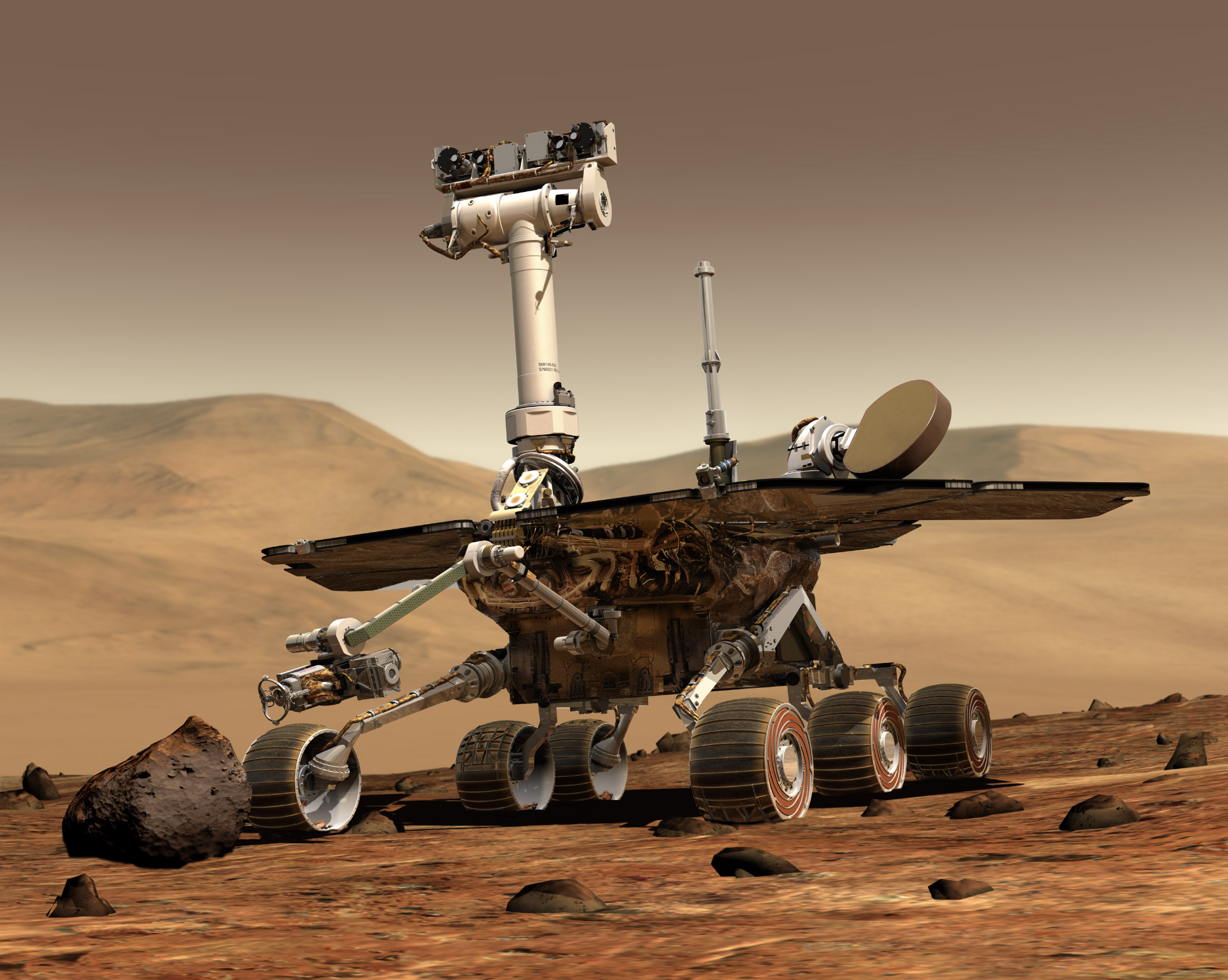
Mars Rover “Opportunity”
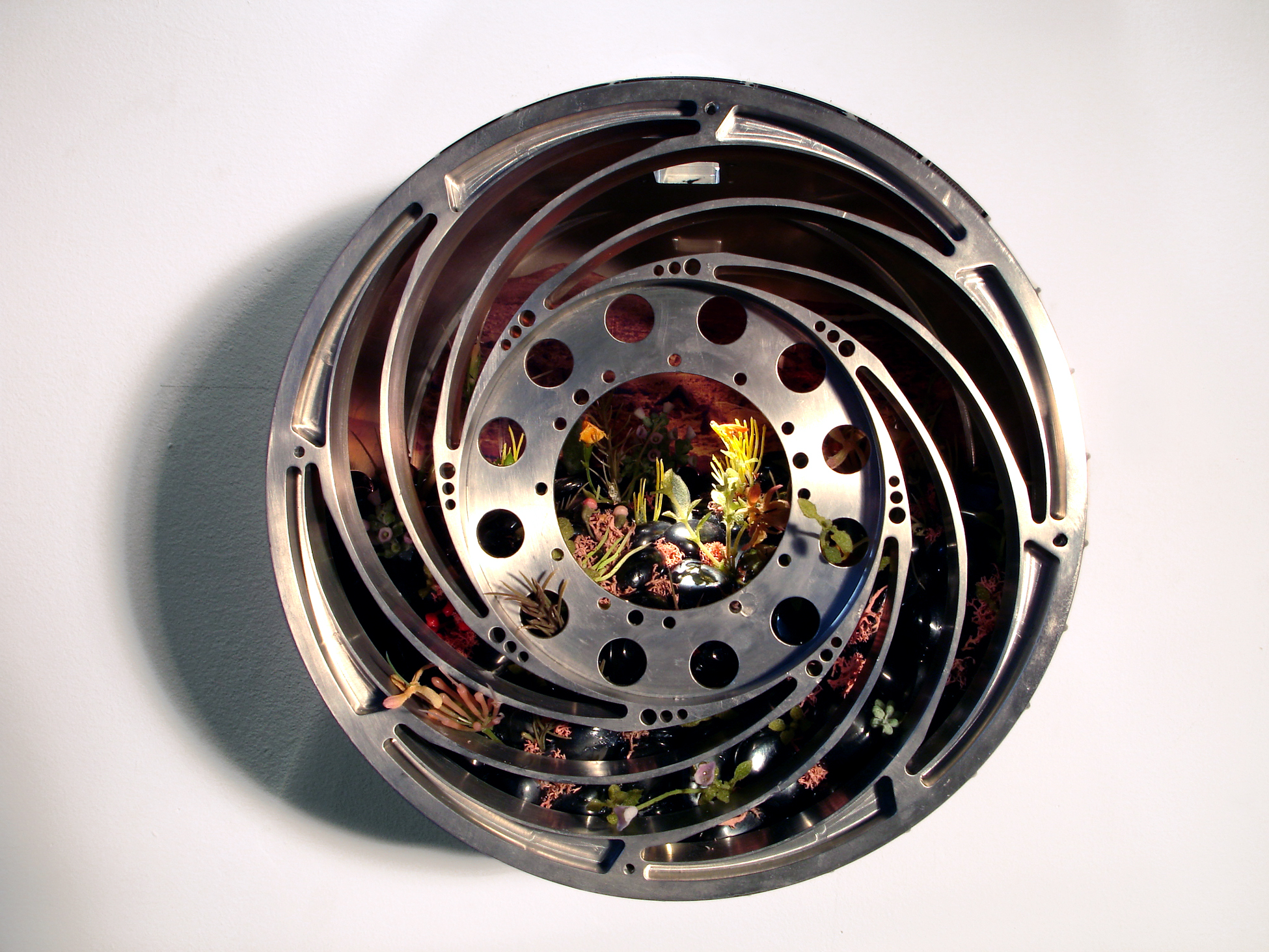
E.V. Day, Wheel of Optimism, 2006, Milled aluminum tire from NASA Mars Rover, hematite rocks, artificial plants and photo, 9” h x 9” w x 8” d
But back to NASA . . . initially, I envisioned a project that would explore the concepts of stealth technology, velocity, and space travel. But most of the people I met were exclusively searching for evidence of water on Mars. I met engineers who were building a machine, named by the acronym RAT, to carve out Martian soil samples. I caught the “search for water” bug from a geologist, who showed me images of the surface of Mars, mostly iron ore with concentrations of sphere-shaped nodules of hematite, referred to as blueberries. I imagined miles of polished reflective hematite rocks like the ones you see at the gift shop at a nature museum, covering the land. To me this image seemed really outer space-y, otherworldly, a little like a backdrop for Barbarella’s habitat, and a new approach to my project was sparked—especially when one of the engineers handed me a spare tire from the Mars rover, and asked, “Could you do anything with this?” He handed it to me, looking straight into my eyes like he was entrusting me with a holy relic, which it kind of is. The idea was that I would return the tire to the space program but as a work of art. It was a magnificent specimen of engineering, a sleek, silver cylinder milled from solid aluminum and measuring 8 inches by 8 inches by 9 inches. As I ran my fingers over its smooth, cool surface, I could feel the weight and precision of its construction. It is the prosthetic toe of humankind on Mars. The tire became the centerpiece of my project, symbolizing the potential for life and growth on Mars. I imagined the interior hollow space as a lush oasis, filled with diverse flora, mineral-rich rocks, and an image of a Martian vista in the background from their archives. The diorama was a tangible representation of my vision for a hydrated Martian world. I ended up making something not just about space but more about hope and the endless quest for discovery.